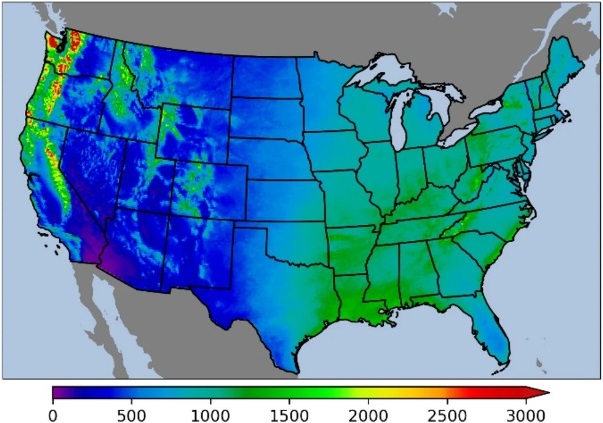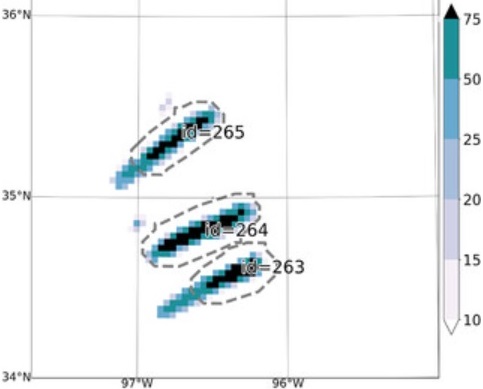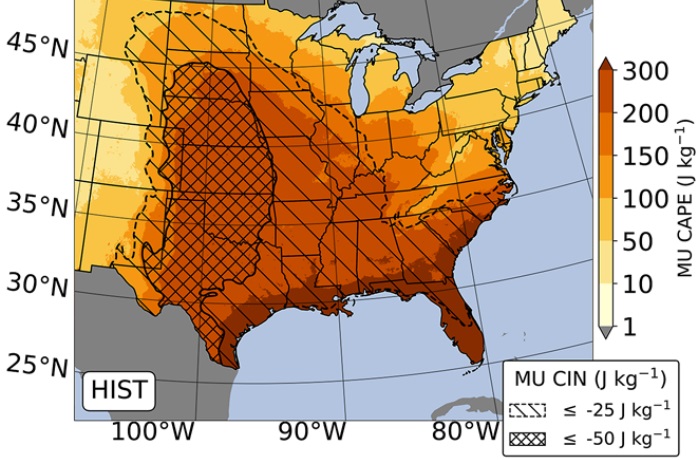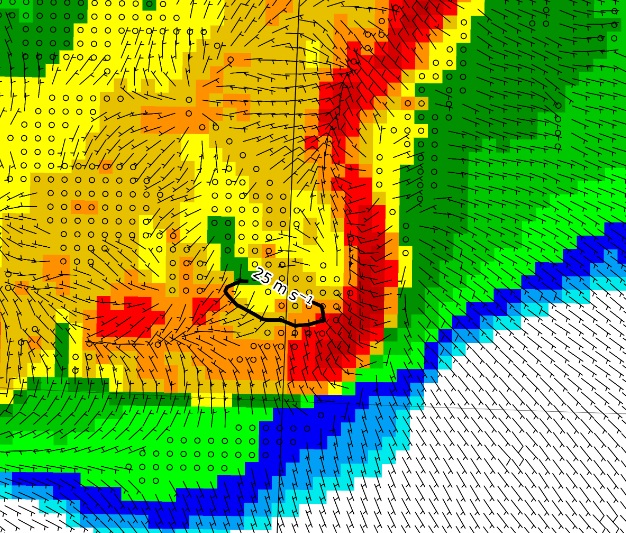WRF - BCC Convection Permitting Regional Climate Model (CP-RCM) Simulations
Regional Climate Simulation Project (2023 - Present)
In 2017, a collaborative group of researchers at Northern Illinois University and Colorado State University were awarded a National Science Foundation grant for a project titled "Observed and Future Dynamically Downscaled Estimates of Precipitation Associated with Mesoscale Convective Systems". The goal of this project was to assess the importance of mesoscale convective system (MCS) precipitation in the United States now and in the future. While myriad observational datasets exist to examine current MCS activity, future projections of MCS activity are much more difficult to generate for a number of reasons, including:
- Critical MCS processes occur at relatively small spatial scales (~1 km) and temporal scales (~1000 s) requiring grid spacings of around 4 km or less;
- Natural, year-to-year, variability in MCS activity requires a sufficiently long simulation period to reveal the stable spatiotemporal frequency of simulated MCSs;
- MCSs are sensitive to distant mesoscale processes, requiring a large modeling domain that encompasses the Conterminous United States (CONUS);
- The high spatiotemporal resolution, continental modeling domain, and long simulation periods require immense computational and storage costs; and
- Analyzing the resulting petabyte-scale dataset requires high-performance computing and specialized software packages and techniques.
Despite these technological barriers, the team generated five sets of simulations covering three different temporal periods and two different warming scenarios--namely, Representative Concentration Pathway (RCP) 4.5 and 8.5 from the 5th iteration of the Coupled Model Intercomparison Project (CMIP5):
| Simulation Name | Integration Period | Start Year | End Year | Spatial Resolution | Temporal Resolution | 3D Data Available | RCM | GCM | Scenario |
|---|---|---|---|---|---|---|---|---|---|
| historical | Water Year (Oct - Sept) |
1990 | 2005 | 3.75 km | 15-min to 1-hr | Yes | WRF-ARW 4.1.2 | CESM1 (Bias-Corrected) | CMIP5 Retrospective |
| mid_century_4p5_FIXED | Water Year (Oct - Sept) |
2040 | 2055 | 3.75 km | 15-min to 1-hr | Yes | WRF-ARW 4.1.2 | CESM1 (Bias-Corrected) | CMIP5 RCP 4.5 |
| mid_century_8p5_FIXED | Water Year (Oct - Sept) |
2040 | 2055 | 3.75 km | 15-min to 1-hr | Yes | WRF-ARW 4.1.2 | CESM1 (Bias-Corrected) | CMIP5 RCP 8.5 |
| end_of_century_4p5 | Water Year (Oct - Sept) |
2085 | 2100 | 3.75 km | 15-min to 1-hr | No | WRF-ARW 4.1.2 | CESM1 (Bias-Corrected) | CMIP5 RCP 4.5 |
| end_of_century_8p5 | Water Year (Oct - Sept) |
2085 | 2100 | 3.75 km | 15-min to 1-hr | Yes | WRF-ARW 4.1.2 | CESM1 (Bias-Corrected) | CMIP5 RCP 8.5 |
Regional Climate Simulation Data
While the bulk of the dataset is on Argonne's Eagle filesystem, select variables have been downloaded to triton for use in graduate student work. This website provides information on where to find certain variables on triton. All projects using the WRF-BCC data must include the following in their Acknowledgements sections (either in thesis, dissertation, and/or paper):
The authors would like to acknowledge high-performance computing support from Cheyenne (https://doi.org/10.5065/D6RX99HX) provided by NCAR's Computational and Information Systems Laboratory, sponsored by the National Science Foundation. This research was supported by the National Science Foundation award numbers 1637225, 1800582, and 2203516 and the National Oceanic and Atmospheric Administration award number NA22OAR4690645. The authors also would like to acknowledge and thank Dr. Michael Papka (Argonne) and the Argonne Leadership Computing Facility at Argonne National Laboratory for data storage and post processing assistance. This research used resources of the Argonne Leadership Computing Facility, which is a DOE Office of Science User Facility supported under Contract DE-AC02-06CH11357.
Associated Awards (Do not include this info in Acknowledgements, but it may be needed for pre-submissions):
- NSF-AGS 1637225 - Observed and Future Dynamically Downscaled Estimates of Precipitation Associated with Mesoscale Convective Systems (PI - Walker Ashley)
- NSF-AGS 1800582 - Observed and Future Dynamically Downscaled Estimates of Precipitation Associated with Mesoscale Convective Systems (PI - Victor Gensini)
- NSF-AGS 2203516 - North American Warm-season Extremes in a Changing Climate: Large-scale Drivers and Local Feedbacks (PI - Allison Michaelis)
- NOAA NA22OAR4690645 - Understanding and Mitigating Future Weather and Climate Risks to Agriculture (PI - Walker Ashley)
More information on WRF-BCC variables:



